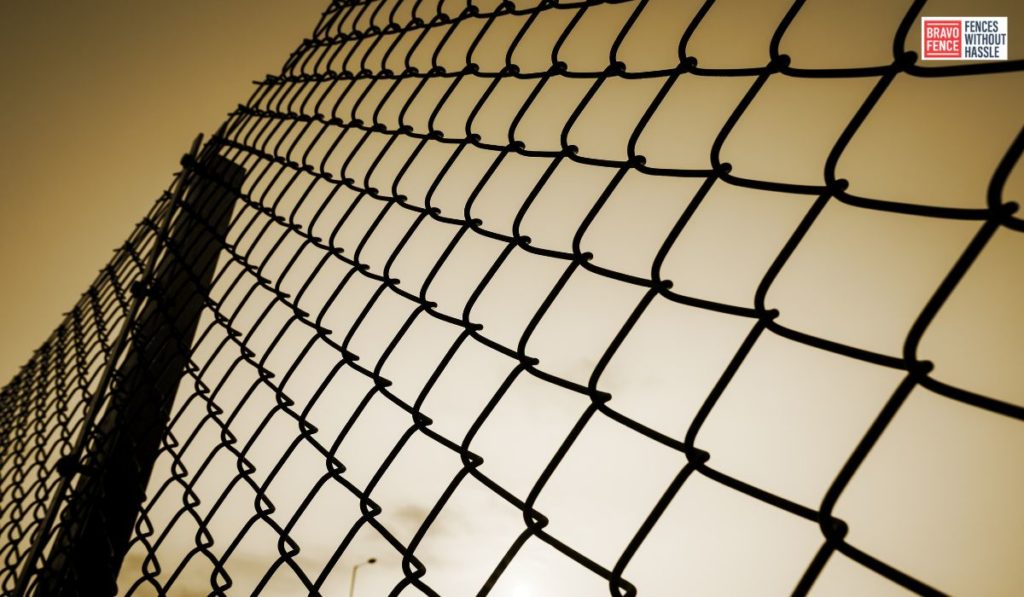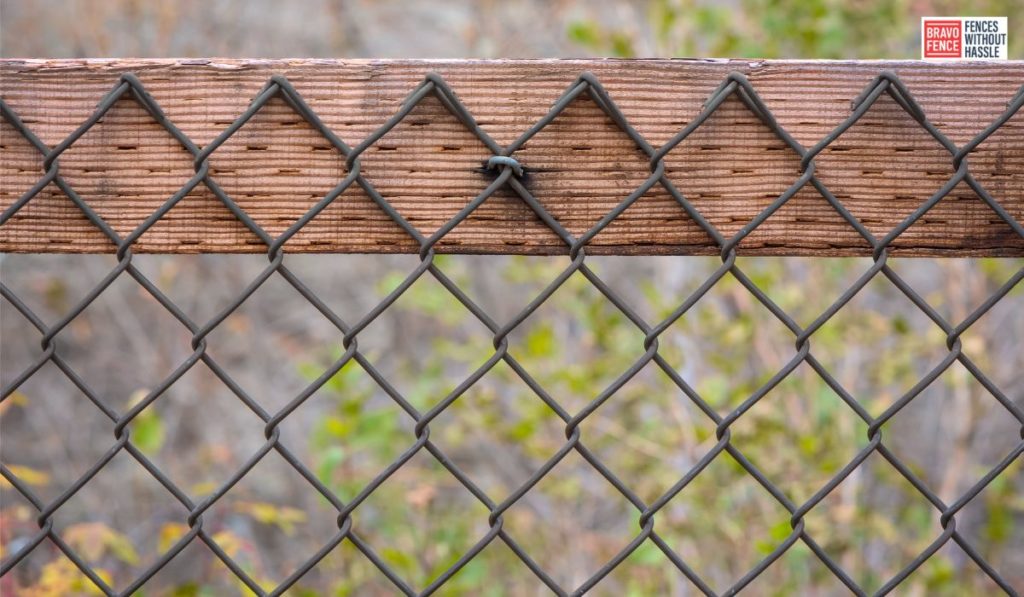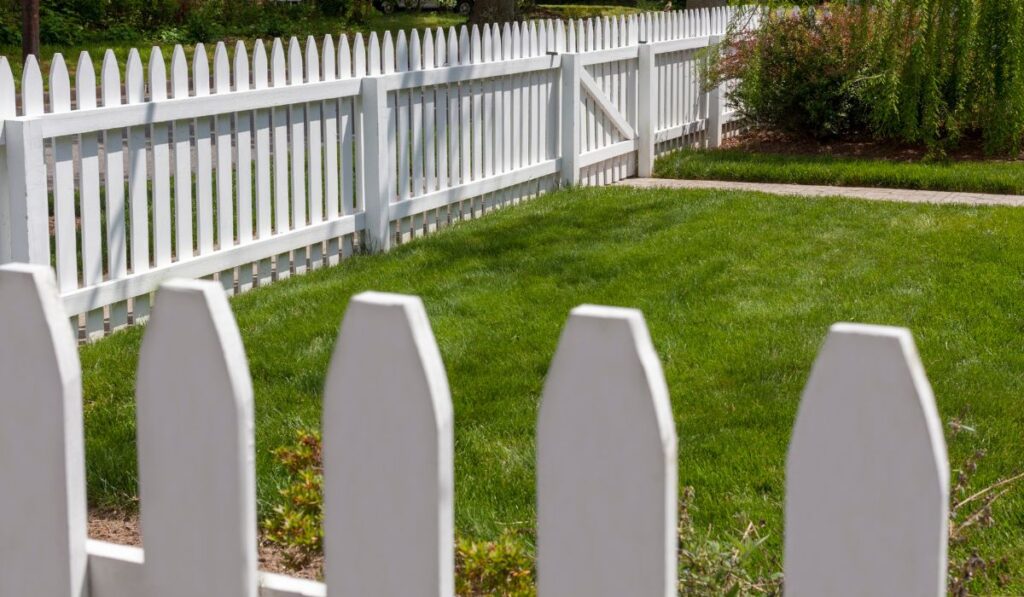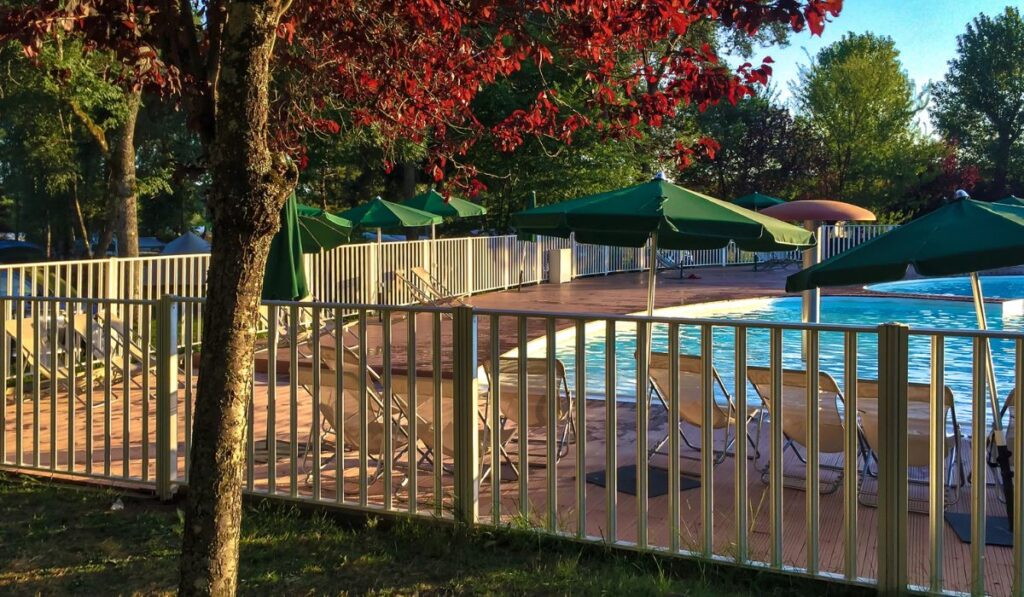Installing a chain link fence with wood posts is a straightforward process that can enhance the aesthetics and functionality of your property. Follow these steps to complete the installation:
- Gather the necessary materials: Chain link fence fabric, wood posts, top rail, tension bands, tension bars, gate hardware, a post hole digger, gravel, concrete, screws, and other essential tools.
- Plan the layout: Determine the boundaries of your fence and mark the locations of the corner, end, and gate posts. Space the line posts evenly, typically 6 to 10 feet apart, depending on the height and strength of the fence.
- Dig the post holes: To dig holes for the wood posts, utilize a post hole digger or auger, which are suitable tools for the task. The depth of the holes should be approximately one-third of the total length of the post, with an additional few inches for gravel and concrete.
- Set the posts: Place the wood posts in the holes and ensure they are level and plumb. Add gravel to the bottom of each hole for drainage, then pour concrete around the bases.
- Attach the fence fabric: Unroll the chain link fence fabric along the length of the fence line. Please attach it to the end and corner posts using tension bands and bars. Use fence ties to secure the fabric to the line posts, spacing them every 2 feet or as the manufacturer recommends.
- Install the top rail: Slide it through the top loops of the chain link fabric and secure it to the posts using fittings or screws. The top rail provides stability and helps to distribute the tension in the fence fabric evenly.
- Add gate and hardware: If you’re installing a gate, attach it to the designated gate post using hinges and latches. Ensure the entrance is level and swings freely.
- Tension the fence fabric: Use a stretcher to pull the chain link fabric taut and secure it to the tension bands on the end and corner posts. Adjust the tension until the material is uniformly stretched along the entire fence.
- Finishing touches: Trim any excess fence fabric, and check for loose fittings or connections. Inspect the entire fence for stability and make any necessary adjustments.
Following these steps, you can install a durable chain link fence with wood posts that offers security and visual appeal to your property.
Why Choose A Chain Link Fence With Wood Posts?

Opting for a chain link fence with wood posts offers several advantages, making it a popular choice among homeowners. Here’s why you might consider this option:
- Affordability: Chain link fences are generally more cost-effective than other fencing options. Combining them with wood posts allows you to create a visually appealing wall without breaking the bank.
- Durability: Durability is a notable characteristic of chain link fences, as they are resistant to rot, pests, and weather conditions. Wood posts add strength and stability to the wall, ensuring it stands the test of time.
- Versatility: Chain link fences are highly versatile and can be installed in various environments, such as residential, commercial, or recreational areas. The addition of wood posts allows for customization and can match the existing aesthetic of your property.
- Security: Chain link fences provide a secure boundary, deterring trespassers and keeping pets and children safely contained. Wood posts enhance the overall strength of the fence, making it more difficult to breach.
- Low maintenance: Chain link fences require minimal maintenance compared to other materials. Wood posts may require occasional staining or sealing to prolong their lifespan, but overall upkeep is relatively simple.
- Visibility: The open weave design of chain link fences allows for visibility inside and outside the property. This can be beneficial for monitoring activities, maintaining sightlines, and creating an open and spacious feel.
When selecting a fence for your property, a chain link fence with wood posts offers an affordable, durable, and versatile solution that can provide security and peace of mind.
Steps To Install Chain Link Fence And Post

Installing a chain link fence with wood posts involves several steps that ensure a successful and secure installation. Here are the key steps to follow:
- Planning and preparation: Determine the fence layout, including the placement of corner, end, and gate posts. Gather all the necessary materials & tools required for the installation.
- Digging post holes: Use a post hole digger or auger to dig holes for the wood posts. The depth should be one-third of the post length plus a few extra inches for gravel and concrete.
- Setting the posts: Place the wood posts in the holes, ensuring they are level and plumb. Fill the bottom of each hole with gravel for drainage, then pour concrete around the bases. Allow the concrete to cure.
- Attaching the fence fabric: Unroll the chain link fence fabric along the fence line. Please attach it to the end and corner posts using tension bands and bars. Secure the material to the line posts with fence ties.
- Installing the top rail: Slide the top rail through the loops in the chain link fabric and secure it to the posts using fittings or screws. This provides stability and helps distribute tension.
- Adding gates and hardware: Attach any gates to designated gate posts using hinges and latches. Ensure the gate swings freely and is level.
- Tensioning the fabric: Use a fence stretcher to pull the chain link fabric taut and secure it to the tension bands on the end and corner posts. Adjust the tension until the material is uniformly stretched.
- Finishing touches: Trim any excess fence fabric and inspect the entire fence for stability. Make any necessary adjustments and ensure all fittings are secure.
By following these steps, you can install a sturdy, secure, and visually appealing chain link fence with wood posts.
Tips To Maintain Your New Fence Post
Once you have installed a chain link fence with wood posts, proper maintenance is essential to ensure its longevity and appearance. Here are a few tips to help you maintain your new fence post:
- Regular cleaning: Clean your fence periodically to remove dirt, debris, and organic growth. Use a mild detergent or wall cleaner and a soft brush or cloth. Rinse thoroughly with water afterward.
- Inspect for damage: Regularly inspect the fence for any signs of wear, such as loose fittings, bent posts, or damaged chain link fabric. Fence Repair & replace any damaged components promptly to prevent further issues.
- Address rust: Chain link fences can develop rust over time, mainly in areas with high humidity or salt exposure. To address surface rust on metal, employ a wire brush to remove it, followed by the application of a rust-inhibiting paint or primer to safeguard the metal.
- Stain or seal wood posts: If your wood posts are not already treated, consider staining or sealing them to protect against moisture, UV rays, and rot. Follow the manufacturer’s instructions for the appropriate stain or sealant.
- Trim vegetation: Regularly trim any vegetation near the fence to prevent it from growing into or around the chain link fabric. Overgrown plants can cause damage and make maintenance more difficult.
- Keep an eye on gate hardware: Check the hinges, latches, and other gate hardware regularly to ensure they are secure and functioning correctly. Lubricate moving parts as needed to prevent rust and maintain smooth operation.
- Monitor soil erosion: Keep an eye on the soil around the base of the wood posts. Add dirt or gravel to fill gaps and stabilize the poles if corrosion occurs.
By following these maintenance tips, you can expand the duration of your chain link fence with wood posts and keep it looking its best for years to come.
FAQs – Chain Link Fence With Wood Post
Can you attach a chain link fence to a wood post?
It is possible to attach a chain link fence to a wood post. The wood posts provide stability and support for the chain link fabric. You can securely connect the chain link fence to the wood posts using appropriate hardware and fittings.
Is it cheaper to build a wood fence or chain link?
Chain link fences are generally more cost-effective than wood fences. The materials for a chain link fence, including the chain link fabric and metal posts, are typically less expensive than those needed for a wood fence. Additionally, chain link fences require less labor-intensive installation, further reducing costs.
How do you attach a metal fence to a wood post?
You can use specific hardware designed for this purpose to attach a metal fence to a wood post. One standard method is to use brackets or straps that wrap around the wood post and secure the metal fence rails or panels. Ensure the hardware is securely fastened and provides a stable connection between the metal fence and the wood post.
How do you attach a wood fence to a chain link?
Attaching a wood fence to a chain link fence requires brackets or hangers designed for this purpose. These brackets or hangers can be attached to the chain link fabric or metal posts, providing a secure connection point for the wood fence rails or panels. Ensure the wood fence is aligned correctly and securely attached to the chain link fence.
Can you install chain link fence posts without concrete?
While concrete is commonly used to secure chain link fence posts, there are alternative methods to install them without concrete. One option is to use gravel and compact it around the base of the post for stability. Another option is to use a specialized post-anchor system that provides stability without needing concrete.
How far apart should T-posts be for a chain link fence?
The spacing of T-posts for a chain link fence depends on various factors, including the height of the wall and the level of tension in the chain link fabric. As a general guideline, T-posts are typically spaced 6 to 10 feet apart along the fence line. However, it is recommended to consult the specific manufacturer’s policies for your chosen chain link fence system.
How much does it cost to install 400 feet of chain link fence?
The cost of installing a 400-foot chain link fence can vary depending on elements such as the height of the wall, the quality of materials, and labor costs in your area. However, the average cost per linear foot for a chain link fence installation ranges from $10 to $25. Therefore, the estimated cost for a 400-foot fence could range from $4,000 to $10,000.
Does a chain link fence decrease property value?
A well-maintained and properly installed chain link fence can enhance the security and functionality of a property, which can increase its value. However, the impact on property value can vary depending on factors such as the location, neighborhood, and overall aesthetics of the fence. Therefore, it is advisable to consider the preferences and expectations of potential buyers in your specific real estate market.
What are the disadvantages of a chain link fence?
Chain link fences have some disadvantages to consider:
- Limited privacy: The open weave design of chain link fences provides little privacy, allowing visibility inside and outside the property.
- Lack of aesthetic appeal: Chain link fences are often considered less visually appealing than other fence materials, such as wood or vinyl.
- Limited noise reduction: Chain link fences do not reduce noise significantly compared to solid or composite walls.
- Rust potential: If not properly maintained, the metal components of a chain link fence can rust over time, affecting both appearance and durability.
What’s the cheapest fence to install?
Chain link fences are the most budget fencing option. They require fewer materials and less labor-intensive installation than fence types such as wood, vinyl, or wrought iron. Therefore, chain link fences are often the cheapest fence installation option.
How do you install fence panels in an existing wooden post?
To install fence panels in existing wooden posts, follow these steps:
- Measure the distance between the existing wooden posts to determine the appropriate width for the fence panels.
- Cut the fence panels to the desired width, ensuring they fit snugly between the wooden sticks.
- Attach the fence panels to the wooden posts using screws or nails, ensuring they are securely fastened.
- Check the alignment and level of the fence panels, making any necessary adjustments.
- Continue installing the remaining fence panels, ensuring consistent spacing and alignment.
Do metal fence posts need concrete?
While concrete is commonly used to secure metal fence posts, it is only sometimes necessary. In some cases, metal fence posts can be installed using alternative methods, such as driving them into the floor with a post driver or anchoring them with specialized ground screws or post anchors. The choice of installation method depends on factors such as soil conditions, fence height, and local building codes.
How much does a 50-foot roll of chain link fence weigh?
The weight of a 50-foot roll of chain link fence can vary depending on the fence fabric’s specific gauge and mesh size. However, as a general estimate, a 50-foot roll of chain link fence fabric can weigh between 50 and 100 pounds.
How do you secure a chain link fence to a post?
To secure a chain link fence to a post:
- Use tension bands and tension bars.
- Wrap the tension bands around the pole and attach them to the fence fabric using tension bars.
- Tighten the tension bands to secure the fence fabric to the base and ensure it is taut and properly aligned.
How can I secure the bottom of my chain link fence?
To fix the bottom of a chain link fence, you can:
- Bury the bottom of the fence fabric: Dig a shallow trench along the fence line and bury the bottom of the chain link fabric. This provides additional stability and prevents animals from digging under the fence.
- Install a bottom tension wire: Attach a tension wire along the bottom of the fence fabric, weaving it through the mesh. Fixed the ends of the wire to the end or corner posts using tension bands and tension bars. This helps reinforce the bottom of the fence and keeps it taut.
How deep should chain link fence posts be buried?
The depth at which chain link fence posts should be buried depends on various factors, including the height of the fence, soil conditions, and local building codes. As a general guideline, poles for a standard residential chain link fence are typically buried 24 to 36 inches deep. It is recommended to consult your local building codes for specific requirements in your area.
Should wooden fence posts be set in concrete?
Setting wooden fence posts in concrete is a common practice to provide stability and support. The concrete helps secure the seats in the ground and prevents shifting or leaning. However, alternative methods, such as gravel or specialized post anchors, can also be used, depending on the specific circumstances and preferences.
How do you secure a wood post without concrete?
If you prefer not to use concrete, alternative methods exist to secure a wood post. Some options include:
- Gravel and compacted soil: Dig a hole for the position, fill it with gravel, and compact the stone tightly. Place the wood post in the excavation and backfill it with soil, tamping it down firmly.
- Post anchors: Utilize post anchors designed for various surfaces, such as ground spikes, drive-in post anchors, or screw-in post anchors. These anchors provide stability without the need for concrete.
How deep should a 6-foot chain link fence post be?
For a 6-foot chain link fence, the posts are typically buried at least 36 inches deep. This depth helps provide the necessary stability and support to withstand wind and other forces acting on the fence. However, local building codes and soil conditions may require different depths, so it is advisable to consult the specific guidelines for your area.
What is the most manageable fence to install yourself?
Chain link fences are considered one of the most accessible barriers to installing yourself. They require fewer materials and less complex construction than other fence types. Also, chain link fences often come in pre-made panels or rolls, simplifying installation.
Should fence posts be 6 or 8 feet apart?
The spacing between fence posts depends on various factors, including the type of fence, the height of the wall, and the level of stability required. As a general guideline, fence posts for a typical residential wall are often spaced 6 to 8 feet apart. However, closer spacing may be necessary for taller or more robust fences to ensure adequate support.
Do I need a permit to put a fence around my yard?
The requirement for a permit to install a fence around your yard varies depending on local regulations and zoning ordinances. For example, some municipalities may require a license for any wall, while others have specific guidelines based on factors such as fence height or location on the property. Therefore, you must check with your local buildings & zoning departments to determine if a permit is required in your area.
How many rolls of chain link can fence an acre?
The number of rolls of chain link fence needed to fence an acre depends on various factors, including the dimensions of the acreage and the desired fence height. With specific measurements, it is easier to provide an accurate estimate. Therefore, it is advisable to consult with a professional fencing contractor who can assess the particular requirements of your project and give a precise material estimate.
Is a chain link fence more expensive than a privacy fence?
In general, chain link fences are less expensive than privacy fences. Materials used in chain link fences, such as chain link fabric and metal posts, are more affordable than those used in privacy fences, such as wood panels or vinyl slats. Additionally, privacy fences often require more labor-intensive installation, increasing overall costs.






